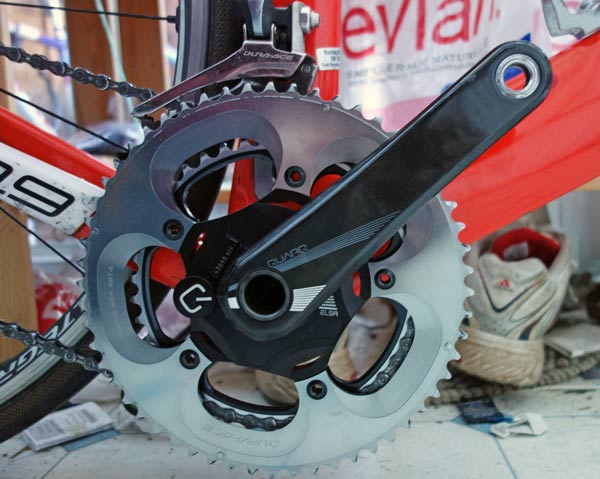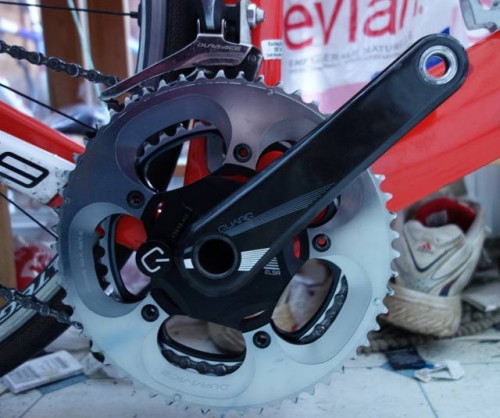If power meters had never been invented I would be quite happy. They cost a lot of money and in the past two years I’ve had more technical problems with power meters than I have had with any other cycling equipment.
On the other hand, it’s hard to push back technological advances, as the Luddites found out all those years ago. Yes, it would perhaps be nice if we all rode single speed steel frames with nothing more than the wind in our face to evaluate how hard we’re trying. But I can’t deny I’d rather have a 6kg Emonda for climbing in the Lake District, and now you can have a power file to look at and muse after. Whether you get as much joy inspecting a power file as you do climbing Hardknott pass, who can say?
My power meters
Quark Elsa
The Quark Elsa is a pain to fit (at least for me – of low technical capacity) and it frequently broke down in the first six months. To be fair, it’s been quite reliable this year and the power figure seems reasonably reliable. However, a dropped chain on Monday did knock off a precariously balanced magnet, showing it’s just another thing that go wrong.
Stages
I bought a Stages power meter crank this April because I wanted one for the road bike, and it was too difficult to swap the Quark cranks / bottom brackets e.t.c. Stages is half the price of Quark and at £700 is moving into the area of reasonably affordable (by cycling standards anyway)
It is relatively easy to fit, you just need a bit of finesse with a torque wrench (something I lacked, rounded a bolt and had to buy a new bolton ebay) Since using in May, the Stages has been reliable and consistent so far.
The main thing about the Stages is that it gives a reading of 30-40 watts more than the Quark. I was really excited to suddenly be getting an extra 40 watts on training rides. Though alas, I still had very similar times to last year’s efforts at 40 watts less. An extra 40 watts means nothing, if you don’t go any faster. That’s the thing with power meters, it still is the time which counts in races (at least for now…)
I’ve tried resetting Stages, but it gives the same high power reading, which is a bit of a pain for comparing power meter outputs between the different bikes, I’m not sure which is right. For a five minute hill, it’s the difference between a watt per kg ratio of around 7.3 or 6.8.
I think there is a way of testing the reliability of power meters and properly recalibrating, but I don’t really have time.
Advantages of power meters
Pacing. Perhaps the most obvious benefit of a power meter is that it will give very useful indicators about good and bad pacing. For anyone doing a time trial, it is really useful information. I started using a power meter after 8 years of racing. I thought I knew how to pace a good time trial. But, a power meter suggested my pacing wasn’t as good as I thought it was. In some cases, it was a real eye opener.
You don’t have to be a timetriallist to benefit from the pacing benefits. Even a sportive rider may benefit from a look at power. If you’re doing over your threshold after the first half an hour, it’s going to be a long six hours in the saddle.
Speed and power. Without a power meter, it is interesting how much importance you can give to speed or average speed. With a power meter, you can have much more confidence in holding back on a tailwind and increasing effort into head wind.
Peaking. The first year I used a power meter was 2014, during the hill climb season. It was very useful for seeing the 3-5 minute power achieved during a race / training session. It enabled me to spot patterns about the consequences of training and racing very hard, with little rest, and then the contrast with racing after a few days rest.
Training to power. Do I train to power? Not really. When training I sometimes look at power; it is an interesting variable. But, I don’t usually have specific power targets. Perhaps I would do better if I did; some riders seem to really believe specific power zones make big difference.
Cda. This is one thing I’ve not been able to pursue yet. But, if you know what you’re doing, with power, you can calculate your CdA – aero drag. This is a huge business in timetrialling these days because it can make such a difference.
Doing races in bad conditions. In time trials, you’re trying to get good time, and good position. If conditions are really slow it can discourage you from racing because your time will be much slower than usual. However, with a power meter, you can still target a power pb. So even on slow days, racing seems more meaningful and you don’t get discouraged by being five minutes slower. On the other hand, if you get a super-quick time, you can still be disappointed because you’re power is less than you hoped for!
Disadvantages of power meters
Slave to power meter. There’s a potential problem the power meter becomes everything and people feel lost without one. Even if you own and use power meters, I think it is good to learn to ride on feel – many advise just riding with power meter hidden away for post race analysis. It is a good skill to ride on feel and see power as a potential guide. You may go into a race with a target power, but if you’re on a bad day, that target power will be no good. I went into BDCA 50 with a target average power of 298 watts, because that’s what I did in 2014. But, I could barely reach 300watts, let alone maintain it for two hours.
Numbers, numbers. I’m a half-hearted cycling romantic. The idea of relying on intuition and feeling to get the best out of yourself sounds better than following a computer display. When I did ECCA 50 without power meter, I quite enjoyed the old school ride of just listening to legs and riding blind without any numbers. But, then I was quite curious to know what power I actually did. That’s the thing with cycling, I always do the ‘old school’ way and then a few years later cotton on to the latest development, perhaps reluctantly, but with the feeling there’s no point in getting left behind. Perhaps by 2023, I will be producing Cda figures for every ride. But, usually after a ride, I only have time / inclination to take a cursory glance at power files. Power meter files in their entirety look pretty complicated and un-enticing when all you want to do is curl up on the sofa, eat food and have a nap. I usually just end up look at max 5 minute power e.t.c.
Boring racing. I’ve heard it say that power meters can make racing boring because riders stick to power limits – making racing more controllable and predictable e.t.c. I’m not convinced by this argument. I don’t think it makes much difference. It depends much more on tactics and the approach of teams.
Unreliability. Probably the biggest problem of power meters is that they have an unreliability – it’s another thing to go wrong, another thing to fix. If you’re a professional team, you don’t have to worry. But, if you’re an amateur, it’s another thing to stretch the bank balance.
Speculation. There seems to be nearly as much column inches written about Froome’s power to output ratio as there does about the race. Sky say something like 5.9, others have calculated from videos – 7.3kg. There are so many uncertainties. Then it can raise the thorny question – what power is very good / suspicious / mutant e.t.c.? I enjoy watching the Tour de France, but not really the side show about power meter speculation. Perhaps an independent body, under WADA / UCI anti doping will examine if it is possible to use power figures for a better profile and understanding of performance and rider profile; then it could perhaps be helpful. The current situation seems unsatisfactory, whichever angle you look at it.
Overall
A power meter has been useful in improving performance. Even though I haven’t fully explored it’s potential. It’s not a magic bullet, but it can definitely add something. Is it essential for bike riders? No. Though if you take racing very seriously, it is helpful.
- Power meters at amazon



Stages is left leg only and result doubled to get the total power. So if your left leg is slightly up on power balance, you will get double the difference extra using Stages. Of course, you mentioned elsewhere about the imbalance of your leg power. Perhaps this is skewing the Stages results? DC Rainmaker site is my definitive source for all things power meter btw. Great reviews and technical blurb on there.
The new firmware for the quark does away with the need for a magnet.
Hi Tejvan,
I’ve been using a power2Max power meter for the last couple of years in all conditions and can say that I haven’t had any technical or reliability problems and numbers seem consistent.
There is no calibrating involved with these as they self calibrate every time you stop pedaling for 2 seconds. Really happy with it.
Hi there
was wondering how you manage the variability of the numbers when pacing using a PM? I really struggle with this as most of routes and sportives are undulating and hilly and any normal road has a bit of variiability which leads to the power readings just jumping wildly! do you use a 3 second average or 30second average? what parameters o you tend to have on your garmin?
sorry a barage of questions there !!
I mostly use 10 sec average. It is hard when doing hilly sportives. For long climbs, I may tend to keep a max of say 360watts. For flat, look to be around 300w.
To be honest, you can’t just ride by numbers, but have to develop ablity to ride on feel, and then see how good that feel was compared to power.